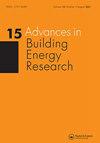Environmental-cost framework to investigate impacts of carbon tax policy on material selection for building structures
IF 2.5
Q2 CONSTRUCTION & BUILDING TECHNOLOGY
引用次数: 0
Abstract
ABSTRACT Building materials, mainly steel and concrete used in residential buildings, significantly impact CO2-eq emissions. Nowadays, carbon tax policy is used in some countries to reduce carbon emission effects. However, few comprehensive studies have been conducted to investigate the overall impact of such a carbon tax policy on minimizing building CO2-eq emissions. Stakeholders in the building industry often focus on cost criteria to select construction materials, neglecting environmental factors. Providing a cost-emission framework can be beneficial in choosing appropriate materials based on financial and environmental factors. This study proposes a comprehensive framework to analyze the embodied CO2 equivalent emission, carbon taxation, and cost of steel and Reinforced Concrete (RC) structures employing Life Cycle Assessment (LCA) methodology. The framework is implemented on an actual residential building case study to validate its potency. The case study’s results show that the embodied CO2-eq emission of the RC structure is 36% higher than the emission in a similar steel structure leading to 36% more carbon taxation. However, the total material cost of the steel structure is around 65% higher than the RC structure. Thus, carbon taxation policy does not necessarily reduce embodied CO2-eq emissions because stakeholders may prioritize the cost criteria to select building materials.调查碳税政策对建筑结构材料选择影响的环境成本框架
住宅建筑中使用的建筑材料,主要是钢材和混凝土,对二氧化碳当量的排放有显著影响。目前,一些国家采用碳税政策来降低碳排放效应。然而,很少有全面的研究来调查这种碳税政策对最小化建筑二氧化碳当量排放的总体影响。建筑行业的利益相关者通常只关注成本标准来选择建筑材料,而忽视了环境因素。提供成本-排放框架有助于根据财政和环境因素选择适当的材料。本研究提出了一个全面的框架来分析隐含的二氧化碳当量排放,碳税,以及采用生命周期评估(LCA)方法的钢和钢筋混凝土(RC)结构的成本。该框架在实际住宅建筑案例研究中实施,以验证其有效性。案例分析结果表明,与同类钢结构相比,钢筋混凝土结构的隐含co2当量排放量高出36%,导致碳税增加36%。然而,钢结构的总材料成本比钢筋混凝土结构高65%左右。因此,碳税政策不一定会减少隐含的二氧化碳当量排放,因为利益相关者可能会优先考虑选择建筑材料的成本标准。
本文章由计算机程序翻译,如有差异,请以英文原文为准。
求助全文
约1分钟内获得全文
求助全文
来源期刊

Advances in Building Energy Research
CONSTRUCTION & BUILDING TECHNOLOGY-
CiteScore
4.80
自引率
5.00%
发文量
11
 求助内容:
求助内容: 应助结果提醒方式:
应助结果提醒方式:


